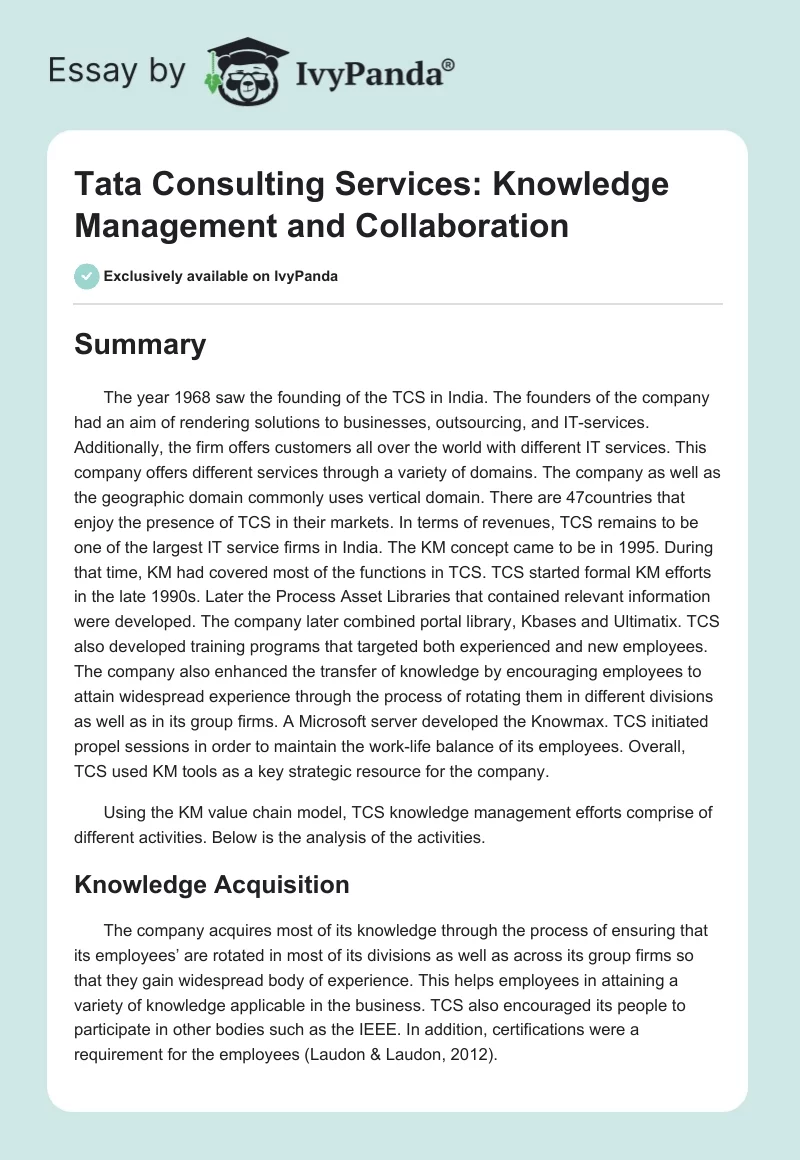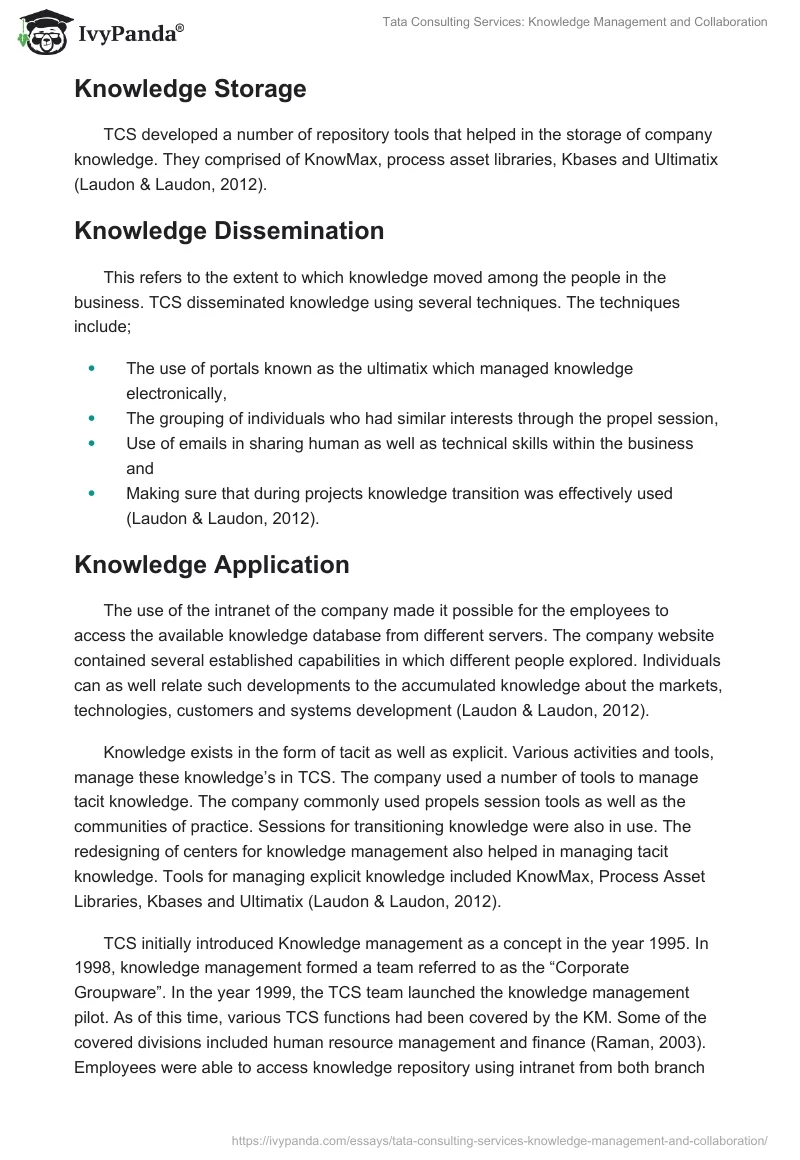Summary
The year 1968 saw the founding of the TCS in India. The founders of the company had an aim of rendering solutions to businesses, outsourcing, and IT-services. Additionally, the firm offers customers all over the world with different IT services. This company offers different services through a variety of domains. The company as well as the geographic domain commonly uses vertical domain. There are 47countries that enjoy the presence of TCS in their markets. In terms of revenues, TCS remains to be one of the largest IT service firms in India. The KM concept came to be in 1995. During that time, KM had covered most of the functions in TCS. TCS started formal KM efforts in the late 1990s. Later the Process Asset Libraries that contained relevant information were developed. The company later combined portal library, Kbases and Ultimatix. TCS also developed training programs that targeted both experienced and new employees. The company also enhanced the transfer of knowledge by encouraging employees to attain widespread experience through the process of rotating them in different divisions as well as in its group firms. A Microsoft server developed the Knowmax. TCS initiated propel sessions in order to maintain the work-life balance of its employees. Overall, TCS used KM tools as a key strategic resource for the company.
Using the KM value chain model, TCS knowledge management efforts comprise of different activities. Below is the analysis of the activities.
Knowledge Acquisition
The company acquires most of its knowledge through the process of ensuring that its employees’ are rotated in most of its divisions as well as across its group firms so that they gain widespread body of experience. This helps employees in attaining a variety of knowledge applicable in the business. TCS also encouraged its people to participate in other bodies such as the IEEE. In addition, certifications were a requirement for the employees (Laudon & Laudon, 2012).
Knowledge Storage
TCS developed a number of repository tools that helped in the storage of company knowledge. They comprised of KnowMax, process asset libraries, Kbases and Ultimatix (Laudon & Laudon, 2012).
Knowledge Dissemination
This refers to the extent to which knowledge moved among the people in the business. TCS disseminated knowledge using several techniques. The techniques include;
- The use of portals known as the ultimatix which managed knowledge electronically,
- The grouping of individuals who had similar interests through the propel session,
- Use of emails in sharing human as well as technical skills within the business and
- Making sure that during projects knowledge transition was effectively used (Laudon & Laudon, 2012).
Knowledge Application
The use of the intranet of the company made it possible for the employees to access the available knowledge database from different servers. The company website contained several established capabilities in which different people explored. Individuals can as well relate such developments to the accumulated knowledge about the markets, technologies, customers and systems development (Laudon & Laudon, 2012).
Knowledge exists in the form of tacit as well as explicit. Various activities and tools, manage these knowledge’s in TCS. The company used a number of tools to manage tacit knowledge. The company commonly used propels session tools as well as the communities of practice. Sessions for transitioning knowledge were also in use. The redesigning of centers for knowledge management also helped in managing tacit knowledge. Tools for managing explicit knowledge included KnowMax, Process Asset Libraries, Kbases and Ultimatix (Laudon & Laudon, 2012).
TCS initially introduced Knowledge management as a concept in the year 1995. In 1998, knowledge management formed a team referred to as the “Corporate Groupware”. In the year 1999, the TCS team launched the knowledge management pilot. As of this time, various TCS functions had been covered by the KM. Some of the covered divisions included human resource management and finance (Raman, 2003). Employees were able to access knowledge repository using intranet from both branch and corporate servers. Different information was contained in the Kbases. The information related to processes and other projects. After the formation of Kbases, the creation of Process Asset Libraries followed (Raman, 2003).
These repositories contained information concerning processes, technology and case studies. TCS then merged the Kbases and portal library later with Ultimatix. Sub-portals helped the company in storing training materials for improving productivity (Raman, 2003). The use of Microsoft portal server aided in developing Knowmax. This enabled TCS consultants to gain access to the experience as well as best practices of about 40 years. The experiences followed an arrangement in terms of customer requirements, the used technology and the type of engagement (Raman, 2003). Knowmax supported numerous assets of KM. Knowledge assets accessibility through the Ultimatix was of much help to the firm associates. The associates played the role of contributing relevant information to the knowledge bank (Raman, 2003). The knowledge officers regulated content quality. Various business activities in the firm advanced due to use of these systems. For instance, the KM systems have increased the success rate in project execution and bidding. KM systems allow consultants to gather information related to the client, thereby rendering better service to them (Raman, 2003).
TCS used several collaboration tools. The Mysite and video conferencing tools were very common in the company business. In addition, the wiki as well as the IdeaStorm was also in use. Other tools comprised of the blogs and the IP telephony.
Benefits
They led to the improvement of local and overseas collaborations because the use of instant messaging dealt with cultural and pronunciation challenges that many people encountered through use of phone. Costs of travelling and telecommunication decreased immensely after adoption of the tools (Holsapple, 2003). The corporate communications enabled all offices of the company to receive news broadcasts internally. Additionally, other tools led to the improvement in communication, knowledge sharing and collaboration among the employees (Holsapple, 2003).
The wikis promoted communication among different people in the business. The blogs improved employees’ productivity. The wikis also offered other support services to the company. The wikis facilitated the presentations developments as well as supporting other essential sessions. Blogs assisted in gathering input to use in solving problems encountered in projects (Holsapple, 2003). The Mysite helped employees in improving communication amongst one another. IdeaStorm assisted corporate groups in coming up with creative topics. The TIP was used in product innovation, helped in solving problems and assisted the management in gathering ideas for product and service innovation. JustAsk System enabled workers to ask questions as well as enabling them to get answers from colleagues (Holsapple, 2003).
TCS accomplishes most of its activities more efficiently and timely. Some of the effective activities include implementation issues of systems as well as their development. Highly innovative solutions provided by the TCS in order to resolve any queries from the customer originate from ideas generated from the KM repositories. Such ideas come from other industries and assist in knowing customer requirements (Holsapple, 2003). It is through the development of KM tools that TCS has improved its value chain. This has led to the improvements in project bidding. TCS now serves clients more efficiently through the KM repositories that improve the performance in project’s practices. It is through this that there is an improved execution in TCS. Accumulated knowledge assists in the coming up with capabilities for understanding methods of strategically servicing people. The use of KM tools has helped TCS in moving higher up, thereby bidding for more strategic projects (Holsapple, 2003).
References
Holsapple, C. W. (2003). Handbook on knowledge management 2, Berlin: Springer.
Laudon, K. C., & Laudon, J. P. (2012). Management information systems: Managing the digital firm, Boston; Munich [u.a.: Pearson.
Raman, A. T. (2003). Knowledge management: A resource book. New Delhi: Excel books.


